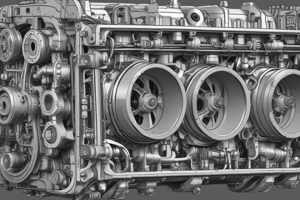Podcast
Questions and Answers
What type of engines are most of the current aircraft engines?
What type of engines are most of the current aircraft engines?
- Water-cooled engines
- Gas turbine based (correct)
- Two-cycle engines
- Rotary engines
What is the primary source of energy production in reciprocating engines?
What is the primary source of energy production in reciprocating engines?
- Fuel combustion (correct)
- Hydraulic pressure
- Electric energy
- Solar power
What is the defining movement of the pistons in reciprocating engines?
What is the defining movement of the pistons in reciprocating engines?
- Back-and-forth or reciprocating (correct)
- Rotational
- Circular
- Up-and-down
What is the main classification method for reciprocating engines mentioned in the text?
What is the main classification method for reciprocating engines mentioned in the text?
What is the primary function of a cylinder in an engine?
What is the primary function of a cylinder in an engine?
What is the role of the piston in a reciprocating engine?
What is the role of the piston in a reciprocating engine?
How does the valve function in the engine?
How does the valve function in the engine?
What is the function of the camshaft in the engine?
What is the function of the camshaft in the engine?
Where does the burning and expansion of gases take place in the engine?
Where does the burning and expansion of gases take place in the engine?
Flashcards are hidden until you start studying
Study Notes
Aircraft Engines
- Most current aircraft engines are reciprocating engines.
Energy Production
- The primary source of energy production in reciprocating engines is the combustion of fuel, typically gasoline or diesel.
Piston Movement
- The defining movement of the pistons in reciprocating engines is a back-and-forth, or up-and-down, motion.
Engine Classification
- The main classification method for reciprocating engines is by the number of strokes of the piston, typically 2-stroke or 4-stroke.
Cylinder Function
- The primary function of a cylinder in an engine is to provide a space for the combustion of fuel and the expansion of gases.
Piston Role
- The role of the piston in a reciprocating engine is to transfer the force generated by the combustion of fuel to the crankshaft, ultimately turning the propeller.
Valve Function
- The valve functions in the engine by controlling the flow of air and fuel into the cylinder and the exhaust gases out of the cylinder.
Camshaft Function
- The function of the camshaft in the engine is to operate the valves, opening and closing them at the correct time to facilitate the combustion process.
Combustion and Expansion
- The burning and expansion of gases take place in the cylinder, driven by the spark plug or fuel ignition.
Studying That Suits You
Use AI to generate personalized quizzes and flashcards to suit your learning preferences.



